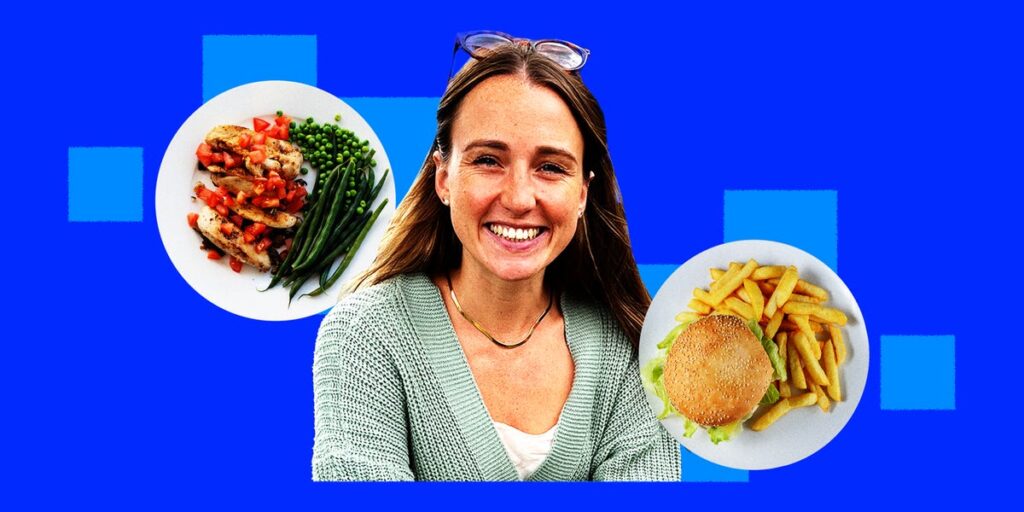- I try to eat up to 130 grams of protein a day, and products like protein powder and bars can help.
- Such foods are often ultra-processed and therefore linked to health risks, so I quit them for a week.
- I didn’t like how the experiment made me fixate on the ingredients in food.
As a fitness and nutrition reporter, I’m slightly ashamed to say I’ve never paid much attention to how many ultra-processed foods I eat. I take a relatively relaxed approach to my diet and have always felt comfortable with the knowledge that whole foods make up most of it.
I mostly focus on eating enough protein and fiber: I don’t track my food intake and haven’t done for years, but I know roughly how to get enough of each in my diet.
Protein is important for overall health but is particularly helpful for active people, such as myself, as it helps muscles repair and rebuild after workouts.
I try to eat around 110 to 130 grams of protein per day, and most days I consume one high-protein UPF like protein powder, fruity high-protein yogurt, or a protein bar, which have all exploded in popularity in recent years.
According to Precedence Research, the global protein market was worth $10.37 billion in 2022 and is forecast to grow to $23.34 billion by 2032.
With more studies pointing to the potential health risks of UPFs, I started to wonder if I could hit my protein target while avoiding them and keeping my calories in check (not just stuffing my face with vast quantities of peanut butter).
For example, UK-based nutritionist Rob Hobson previously told Business Insider that he used to eat protein bars every day but cut down once he learned about the link between UPFs and a host of health issues plus weight gain.
I tried cutting out high-protein UPFs for a week. There’s no set definition for a UPF, but it’s widely considered to mean any food or drink containing an ingredient you wouldn’t have in your own kitchen, such as emulsifiers. So that’s how I chose what to avoid.
It was doable but required a lot of effort, and my diet also became more boring.
Here are four lessons I learned.
I had to pay close attention to ingredient lists
The night before I started my experiment, I made some overnight oats for the following morning — without my usual scoop of protein. Instead, Greek yogurt and chia provided protein, and honey gave flavor and sweetness.
It wasn’t until I was lying in bed that night that I realized I’d unthinkingly used almond milk — a UPF — as I would normally.
Not a great start.
Come lunchtime, and having not had time to go to the grocery store, I assessed the bread options in the freezer. One loaf was UPF, one, fortunately, wasn’t. While I was already aware of “sourfaux” — fake sourdough bread — I decided to pay more attention to which bread I buy.
I was also pleased to find that the store-bought soup in my fridge was not a UPF either. So my go-to winter lunch of soup with a grilled cheese sandwich on sourdough bread was safe.
When I went to the store, however, I realized not all soups are created equal, and sadly some of my favorites were UPFs.
I didn’t like feeling that foods were off-limits
It was hard to think of high-protein snacks to eat aside from more Greek yogurt. Some days I had an apple with peanut butter, but that got boring after a while and isn’t as high in protein as some people think.
Satisfying my sweet tooth wasn’t particularly easy either — I don’t always want high-protein snacks, sometimes I just want a sweet treat. Nothing in my food cupboard was UPF-free, and I realized I’d have to bake from scratch, so blueberry muffins it was.
As I gazed longingly at the chocolate in my cupboard, I started to feel uneasy. Having food “off-limits” felt all too familiar. It reminded me of being in the throes of diet culture 10 or so years ago, back when I thought certain foods were “bad” (which, of course, made me want them even more).
As someone who’s come a long way and put a lot of work into breaking free from this restrictive mindset, I didn’t like the feeling that there were foods I couldn’t eat.
Small swaps helped me avoid UPFs
I usually cook dinners from scratch and I realized I could make small tweaks to ensure they were UPF-free. For example, I like making pasta sauces with cream cheese, but I realized that some brands were UPF and others weren’t.
Grocery shopping took longer than usual, but I figured that was inevitable at the start of the experiment and it would become less time-consuming as I learned which foods were UPF-free.
As a meat-eater, I find it easy to eat enough protein at dinner, and I regularly make dishes combining both meat and pulses — like a chili con carne with black beans — for the varied nutrients they provide.
However, I was conscious of needing my dinner to do even more heavy lifting to hit my protein goal while avoiding UPFs. So I opted for pea pasta rather than the usual wholewheat, which contained 15 grams more protein per 100 grams. I preferred the texture and taste of regular pasta.
My diet was more boring
As the week wore on, I got bored of eating the same meals. The cinnamon and raisin bagels in the freezer and the cereal in my cupboard teased me as I ate the same two breakfasts on repeat (overnight oats with cow’s milk and sourdough toast with a side of Greek yogurt).
I’m sure I could have been more experimental, but avoiding UPFs was taking enough planning without having to find new recipes to try.
I managed to hit my protein target of 110 to 130 grams of protein each day, but my diet felt a bit less exciting.
Come the weekend, when my fiancé wanted to order a pizza, I decided that life was too short to miss out, even for a one-off experiment.
Ultimately, while most dietitians advise people to take a food-first approach to hitting their various health targets, they aren’t saying people need to eliminate UPFs, but most of us could benefit from cutting down. This experiment has made me more conscious of where I could make small tweaks that aren’t too much effort.
But I’m not going to stress too much about having a scoop of protein powder here or there.
Read the full article here
















